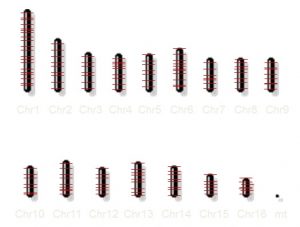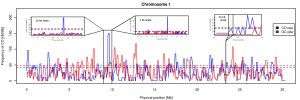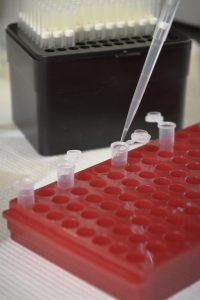Honey bees have the highest meiotic recombination rate among multicellular organisms. Several hypotheses exist to explain why these extraordinarily high rates of chromosome exchanges happen in honey bees and some other social insects. However, we need more information to satisfactorily answer this question. We are interested in generating and analyzing genomic data from other species of honey bees and social insects to explore the link between high recombination rates and social evolution. In addition, we like to know how variable and environmentally responsive the recombination rate within the species Apis mellifera is. We complement these studies with efforts to elucidate the mechanisms of meiotic recombination in honey bees. Studying the mechanistic changes that allow the high rates of crossovers between honey bee chromosomes may allow us to better understand the process of meiotic recombination and its regulation in general, with potential human health implications.



Examples:
Rueppell O., Kuster R. , Miller K. , Fouks B., Rubio Correa S., Collazo J., Phaincharoen M., Tingek S., & Koeniger N. (2016) A new metazoan recombination rate record and consistently high recombination rates in the honey bee genus Apis accompanied by frequent inversions but not translocations. Genome Biology and Evolution, 8(12): 3653-3660.
Sadd B.M., Barribeau S.M., et al. (List of 142 Authors including Rueppell, O.) (2015) The genomes of two key bumblebee species with primitive eusocial organization. Genome Biology, 16:76.
Ross C., DeFelice D., Hunt G., Ihle K., Amdam G.V. & Rueppell O. (2015) Genomic correlates of recombination rate and its variability across eight recombination maps in the Western Honey Bee (Apis mellifera L.). BMC Genomics, 16:107.
Elsik C.G., Worley K.C., Bennett A.K., Beye M., Camara F.C., Childers C.P., de Graaf D.C., Debsyer G., Deng J., Devreese B., Elhaik E., Evans J.D., Foster L.J., Graur D., Guigo R., Hoff K.J., Holder M.E., Hudson M.E., Hunt G.J., Jiang H., Joshi V., Khetani R.S., Kosarev P., Kovar C.L., Ma J., Maleszka R., Moritz R.F.A., Munoz-Torres M.C., Murphy T.D., Muzny D.M., Newsham I.F., Reese J.T., Robertson H.M., Robinson G.E., Rueppell O., Solovyev V., Stanke M., Stolle E., Tsuruda J.M., Van Vaerenbergh M., Waterhouse R.M., Weaver D.B., Whitfield C.W., Wu Y., Zdobnov E.M., Zhang L., Zhu D., and Gibbs R.A. (2014) Finding the missing honey bee genes: lessons learned from a genome upgrade. BMC Genomics, 15(1):86
Rueppell O., Meier S., Deutsch R. (2012) Multiple mating but not recombination causes quantitative increase in offspring genetic diversity for varying genetic architectures. PLoS ONE, 7(10): e47220.
Meznar E.R., Gadau J., Koeniger N., Rueppell O. (2009) Comparative linkage mapping suggests a high recombination rate in all honey bees. Journal of Heredity, 101: S118-S126.
Beye M., Gattermeier I., Hasselmann M., Gempe T., Schioett M., Baines J., Schlipalius D., Mougel F., Emore C., Rueppell O., Sirviö A., Guzmán-Novoa E., Hunt G., Solignac M., Page R.E. (2006) Exceptionally high levels of recombination across the honey bee genome. Genome Research, 16: 1339-1344.